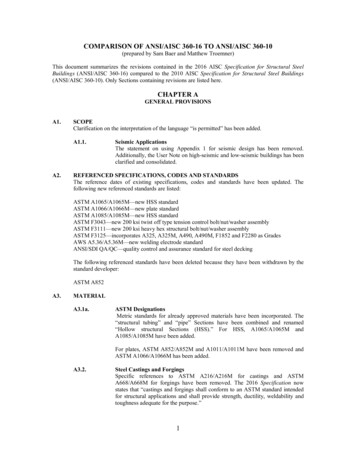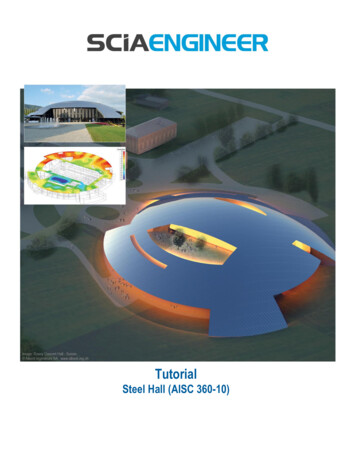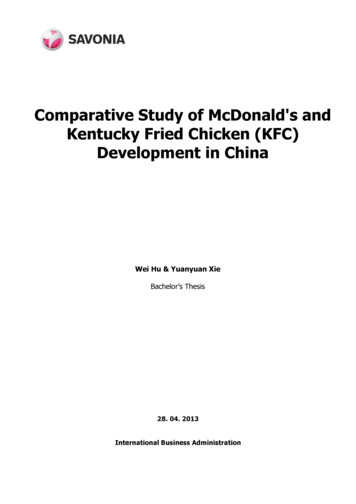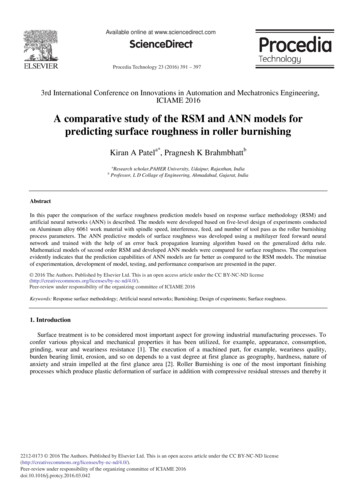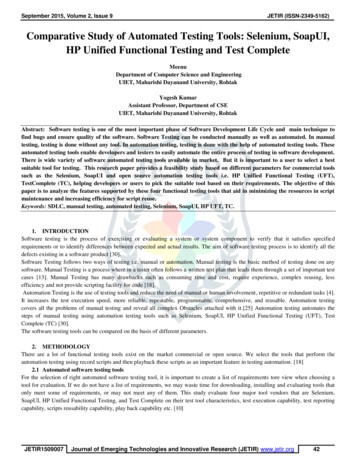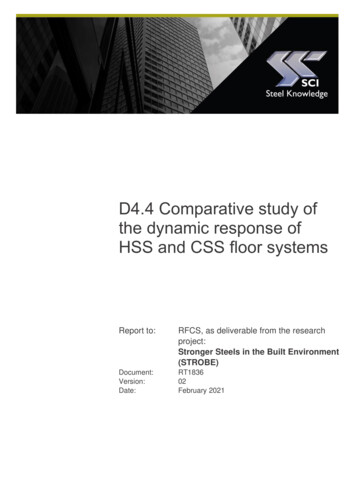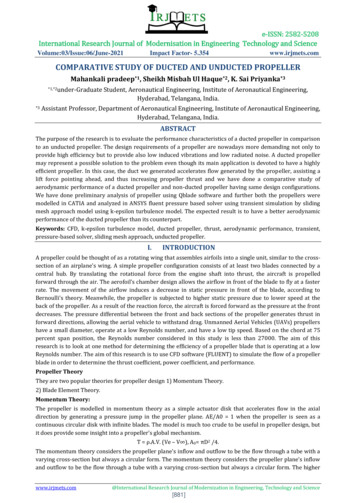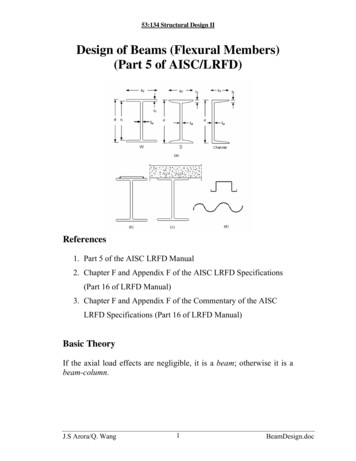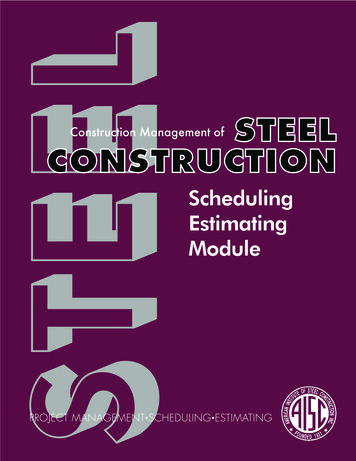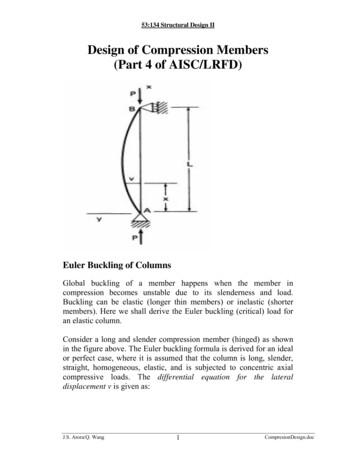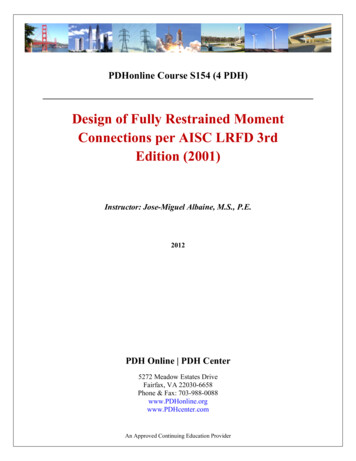
Transcription
A COMPARATIVE STUDY OF AISC-360 AND EUROCODE 3 STRENGTHLIMIT STATESA THESIS SUBMITTED TOTHE GRADUATE SCHOOL OF NATURAL AND APPLIED SCIENCESOFMIDDLE EAST TECHNICAL UNIVERSITYBYSERKAN ŞAHİNIN PARTIAL FULFILLMENT OF THE REQUIREMENTSFORTHE DEGREE OF MASTER OF SCIENCEINCIVIL ENGINEERINGSEPTEMBER 2009
Approval of the thesis:A COMPARATIVE STUDY OF AISC-360 AND EUROCODE 3STRENGTH LIMIT STATESsubmitted by SERKAN ŞAHİN in partial fulfillment of the requirements forthe degree of Master of Science in Civil Engineering Department, MiddleEast Technical University by,Prof. Dr. Canan ÖzgenDean, Graduate School of Natural and Applied SciencesProf.Dr. Güney ÖzcebeHead of Department, Civil EngineeringAssoc. Prof. Dr. Cem TopkayaSupervisor, Civil Engineering Dept., METUExamining Committee MembersProf. Dr. Çetin YılmazCivil Engineering Dept., METUAssoc. Prof. Dr. Cem TopkayaCivil Engineering Dept., METUAsst. Prof. Dr. Alp CanerCivil Engineering Dept., METUAsst. Prof. Dr. Afşin SarıtaşCivil Engineering Dept., METUDr. Serap CılızMitengDate: 03.09.2009
I hereby declare that all information in this document has been obtained andpresented in accordance with academic rules and ethical conduct. I alsodeclare that, as required by these rules and conduct, I have fully cited andreferenced all material and results that are not original to this work.Name, Last name : Serkan ŞAHİNSignatureiii:
ABSTRACTA COMPARATIVE STUDY OF AISC-360 AND EUROCODE 3STRENGTH LIMIT STATESŞahin, SerkanM.S., Department of Civil EngineeringSupervisor: Assoc. Prof. Dr. Cem TopkayaSeptember 2009, 113 pagesNowadays; design, fabrication and erection of steel structures can be takenplace at different locations as a result of rapid globalization; owners may requirethe use of widely accepted steel design codes. Therefore, engineers are faced withthe challenge of being competent with several design specifications for aparticular material type. AISC-360 and EC3 are widely accepted steel structuredesign specifications that utilize limit state principles with some similarities anddifferences in application. Hereby a study has been undertaken to put together thenominal strength expressions presented in both AISC-360 and EC3 codes in asingle document, to identify the similarities and the differences in calculatedstrengths and to facilitate rapid learning of either of the specifications with priorknowledge of the other. Because of the wide scope of specifications, onlyfundamental failure modes are considered in this thesis. Resistance equations aredirectly compared with each other wherever possible.For cases where thetreatment of specifications is entirely different, representative members wereconsidered for comparison purposes.iv
Keywords: Limit state design, AISC-360, eurocode 3, cross-sectionclassification, tension member, compression member, flexural member, sheardesign, bolts, welds.v
ÖZAISC-360 VE EUROCODE 3 ŞARTNAMELERİNİN DAYANIM LİMİTDURUMLARININ KARŞILAŞTIRILMASIŞahin, SerkanYüksek Lisans, İnşaat Mühendisliği BölümüTez Yöneticisi: Doç. Dr. Cem TopkayaEylül 2009, 113 sayfaGünümüzde hızlı küreselleşmenin bir sonucu olarak; çelik yapılarıntasarım, üretim ve uygulama yerlerinin birbirlerinden farklı yerlerde yapılması,işverenleri geniş kabul görmüş çelik yapı şartnamelerini kullanmaya mecburbırakmıştır. Bu da mühendisleri belirli bir malzeme üzerinde farklı şartnameleriuzmanlıkla kullanabilmeleri durumuyla yüz yüze bırakmıştır. AISC-360 ve EC3limit durum kurallarını uygulamada bazı benzerlik ve farklılıklarla kullanan, radaAISC-360veEC3şartnamelerinin nominal dayanım denklemlerini tek bir dökümanda toplamak,şartnamelerde yer alan dayanım denklemlerinin benzerliklerini ve farklılıklarınıbelirtmek ve şartnameleri incelemek açısından bir ön bilgi olması amaçlanarak birçalışma yürtülmüştür. Şartnamelerin çok geniş kapsamlı olması nedeniyle, buradasadece temel kontrol durumları incelenmiştir. Direnç denklemleri mümkün olannoktalarda direkt olarak karşılaştırılmıştır. Şartnamelerin tamamen farklı olandurumlarında ise örnek elemanlar kullanılarak karşılaştırma yapılmıştır.vi
Anahtar kelimeler: Limit durum tasarımı, AISC-360, eurocode 3, kesitsınıflandırılması, çekme elemanı, basınç elemanı, eğilme elemanı, kesme tasarımı,civatalar, kaynaklar.vii
To My Familyviii
ACKNOWLEDGMENTSThis study was performed under the supervision of the Dr. Cem TOPKAYA.I would like to express my sincere thanks and appreciations for his invaluablesupport, guidance, encouragement, criticisms and insights throughout this study.It was a great honor and pleasure to work with him.I also would like to express my deepest thanks to my parents for the support,friendship, encouragement, and understanding that they have provided for methroughout my life.ix
TABLE OF CONTENTSPAGEABSTRACT ivÖZ.viACKNOWLEDGMENTS. .ixTABLE OF CONTENTS .xLIST OF TABLES .xiLIST OF FIGURES .xiiLIST OF SYMBOLS AND ABBREVIATIONS .xivCHAPTER1. INTRODUCTION 11.1 Motivation .11.2 Layout of Specification .21.3 Load Factors and Load Combinations .31.4 Materials 51.5 Organization of the Thesis 52. CLASSIFICATION OF CROSS SECTIONS .63. DESIGN OF MEMBERS FOR TENSION .94. DESIGN OF MEMBERS FOR COMPRESSION .125. DESIGN OF MEMBERS FOR FLEXURE .165.1 Limit State of Yielding – Laterally Supported Beams 165.1.1 Members with Compact Flanges (Class 1 or 2) 165.1.2 Members with Compact Webs (Class 1 or 2) 245.2 Lateral Torsional Buckling of Compact I-shaped Members .316. DESIGN OF MEMBERS FOR SHEAR 396.1 Definition of Shear Area .396.2 Design Strength of Shear .417. DESIGN OF CONNECTIONS .487.1 Welds 48x
7.1.1 Fillet Welds .487.1.1.1 Simplified Method .497.1.1.2 Directional Method .507.1.2 Complete Joint Penetration Welds .517.1.3 Partial Joint Penetration Welds .527.2 Bolts .537.2.1 Maximum and Minimum End-Edge Spacings .547.2.2 Bolt Tension Capacity .557.2.3 Bolt Shear Capacity 567.2.4 Bolt Combined Tension and Shear Capacity .578. CONCLUSIONS 60REFERENCES .64APPENDICESA. Limit State Yielding Comparison Values of LaterallySupported Beams for Compact Flange Sections 65B. Limit State Yielding Comparison Values of LaterallySupported Beams for Compact Web Sections .76C. Values for Lateral Torsional Buckling Comparison 107xi
LIST OF TABLESTABLESTable 2.1: Classification of Cross-Sections .7Table 3.1: Table of Shear Lag Factorsn(AISC-360) 10Table 5.5: Imperfection Factor; αLT (EC3) .33Table 6.1: Contribution from the Web χW to ShearBuckling Resistance in EC3 43Table 7.1: Nominal Yield and Ultimate TensileStrength of Bolts (EC 3) .53Table 7.2: Nominal Yield and Ultimate TensileStrength of Bolts (AISC-360) .54Table 7.3: Maximum. and Minimum End-Edge Distances .55Table A.1: Numerical Values of Compact Flange Cross Sections(Fy 235 MPa) .66Table A.2: Numerical Values of Compact Flange Cross Sections(Fy 355 MPa) .71Table B.1: Numerical Values of Compact Web Cross Sections(Fy 235 MPa) .77Table B.2: Numerical Values of Compact Web Cross Sections(Fy 235 MPa) .92Table C.1: Numerical Values of IPE 400 Section (Fy 235 MPa) .108Table C.2: Numerical Values of IPE 400 Section (Fy 355 MPa) .109Table C.3: Numerical Values of HEB 500 Section (Fy 235 MPa) 110Table C.4: Numerical Values of HEB 500 Section (Fy 355 MPa) 112xii
LIST OF FIGURESFIGURESFig. 4.1: Selection of Buckling Curve for a Cross Section (EC3).14Fig. 4.2: Comparison of Reduction Factors for Flexural Bucklingbetween AISC-360 and EC3 .15Fig. 5.1: Effective Class 2 Cross Section .18Fig. 5.2: Class 4 Cross Section for Bending Moment 19Fig. 5.3: Normalized Moment Capacity vs. Web Slenderness forFy 235 MPa .21Fig. 5.4: Normalized Moment Capacity vs. Web Slenderness forFy 355 MPa .22Fig. 5.5: Normalized Moment Capacity vs. Web Slenderness forFy 235 MPa .23Fig. 5.6: Normalized Moment Capacity vs. Web Slenderness forFy 355 MPa .23Fig. 5.7: Class 4 Flange Effective Cross Section for Bending Moment 26Fig. 5.8: Normalized Moment Capacity vs. Flange Slenderness forFy 235 MPa (AISC-360) .27Fig. 5.9: Normalized Moment Capacity vs. Flange Slenderness forFy 235 MPa (EC3) .28Fig. 5.10: Normalized Moment Capacity vs. Flange Slenderness forFy 355 MPa (AISC-360) 28Fig. 5.11: Normalized Moment Capacity vs. Flange Slenderness forFy 355 MPa (EC3) .29Fig. 5.12: Normalized Moment Capacity vs. Flange Slenderness forFy 235 MPa 30Fig. 5.13: Normalized Moment Capacity vs. Flange Slenderness forFy 355 MPa 30xiii
Fig. 5.14: IPE 400-Normalized Moment Capacity vs. SectionSlenderness for Fy 235 MPa 34Fig. 5.15: IPE 400- Normalized Moment Capacity vs. SectionSlenderness for Fy 355 MPa.34Fig. 5.16: HEB 500- Normalized Moment Capacity vs. SectionSlenderness for Fy 235 MPa 35Fig. 5.17: HEB 500- Normalized Moment Capacity vs. SectionSlenderness for Fy 355 MPa.35Fig. 5.18: IPE 400- Normalized Moment Capacity vs. SectionSlenderness for Fy 235 MPa.36Fig. 5.19: IPE 400- Normalized Moment Capacity vs. SectionSlenderness for Fy 355 MPa .37Fig. 5.20: HEB 500- Normalized Moment Capacity vs. SectionSlenderness for Fy 235 MPa .38Fig. 5.21: HEB 500- Normalized Moment Capacity vs. SectionSlenderness for Fy 355 MPa .38Fig. 6.1: Effective Shear Area for Rolled I Shapes in EC3 40Fig. 6.2: Effective Shear Area for Welded I Shapes in EC3 .40Fig. 6.3: Effective Shear Area for I Shapes in AISC-360 .41Fig. 6.4: Normalized Shear Capacity for a/h 0.5 and Fy 235 MPa .45Fig. 6.5: Normalized Shear Capacity for a/h 1.0 and Fy 235 MPa .45Fig. 6.6: Normalized Shear Capacity for a/h 3.0 and Fy 235 MPa .46Fig. 6.7: Normalized Shear Capacity for a/h 6.0 and Fy 235 MPa .46Fig. 7.1: Throat Thickness of a Fillet Weld .49Fig. 7.2: Stresses on the Throat Section of a Fillet Weld .50Fig. 7.3: Bolt Orientations .54Fig. 7.4: Shear & Tension Interaction Diagram-Threads Excluded .58Fig. 7.5: Shear & Tension Interaction Diagram-Threads Included 59xiv
LIST OF SYMBOLS AND ABBREVIATIONSA:accidental actionA b:gross cross section area of the boltAc:area in compressinA d:design value of accidental actionAEd:design value of seismic actionAc,eff:effective cross sectional areaA f:area of flangeA g:gross area of memberA n:net area of memberAw:web areaA s:tensile stress area of the boltAwl:effective area of the weldCb:lateral-torsional buckling modification factor for uniform momentdiagrams when both ends of the unsupported segment are bracedCv:web shear coefficientCw:warping constantD:dead loadE:earthquake loadE:modulus of elasticity of steelEd :is the design value of the effect of actions such as internal force, momentor a vector representing several internal forces or momentsFEXX: electrode strengthFnt:nominal tensile stressFnv:nominal shear stressFy:specified minimum yield stress of the type of steel being usedFyf:specified minimum yield stress of the flangeFyw:specified minimum yield stress of the webF u:specified minimum tensile strength of the type of steel being usedxv
Fub:ultimate tensile strength of boltFw:nominal strength of the weld metal per unit areaG:permanent actionGEO: Failure or excessive deformation of the ground where the strengths of soilor rock are significant in providing resistanceH:load due to lateral earth pressure, ground water pressure, or pressure ofbulk materialsJ:torsional constantK:effective length factorL:live loadL:length of the memberLb :length between points that are braced against lateral displacementLp :limiting laterally unbraced length for the limit state of yieldingLr :limiting laterally unbraced length for the limit state of inelastic-torsionalbucklingLr :roof live loadMEd:design value of the bending momentMf,Rd: moment resistance of the cross section consisting of the area of theeffective flanges onlyM n:nominal flexural strengthM p:plastic flexural strengthMy:yield moment about the axis of bendingP:prestressing actionP n:nominal axial strengthQ:variable actionR:rain loadRpg:bending strength reduction factorS:snow loadSeff:effective section modulusS x:elastic section modulusxvi
STR: Internal failure or excessive deformation of the structure or structuralmembers, including footings, piles, basement walls, etc., where thestrength of construction materials of the structure governsW:wind loadU:shear lag factorV n:nominal shear strengthV p:plastic design shear strengthZ:plastic section modulus about the axis of bendinga:clear distance between transverse stiffenersbc:compression length of webbeff:effective plate widthbf:flange widthbt:tension le
AISC-360 and EC3 are widely accepted steel structure design specifications that utilize limit state principles with some similarities and differences in application. Hereby a study has been undertaken to put together the nominal strength expressions presented in both AISC-360 and EC3 codes in a single document, to identify the similarities and the differences in calculated strengths and to .
